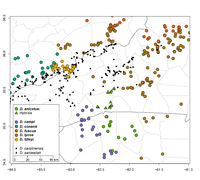Taxonomy
Class: AmphibiaOrder: CaudataFamily: PlethodontidaeSubfamily: PlethodontinaeAuthor: Pyron and Beamer, 2023
Taxonomic Comments: The Spotted Dusky Salamander (Desmognathus conanti ) and Northern Dusky Salamander (D. fuscus ) as traditionally recognized by herpetologists have a long and complex taxonomic history, with the former originally described as a subspecies of D. fuscus . It was treated as such until genetic studies revealed that it is not closely related to the latter (Beamer and Lamb 2008; Kozak et al. 2005). According to the latest systematic treatment of these species by Pyron and Beamer (2023a) At least 10 other currently recognized species of Desmognathus were either described from populations previously considered to be D. fuscus , described as or later considered to be subspecies of D. fuscus , or later considered to be synonyms of D. fuscus before ultimately being recognized as distinct species. The latest molecular analyses have also revealed extensive cryptic diversity within both D. conanti and D. fuscus as currently conceived, with these two species constituting a polyphyletic assemblages of 13 distinct mitochondrial lineages and perhaps as many as 11 candidate species. Pyron and Beamer (2023a) provide a very comprehensive review of the taxonomic history of this group. Desmognathus species and lineages. Gene exchange has occurred between both phylogenetically sister and geographically adjacent populations, as well as between distantly related and spatially separated groups. In summary, both D. conanti and D. fuscus are now each known to represent polyphyletic assemblages of multiple, geographically well-defined candidate species that are phylogenetically interdigitated with other recognized species. The candidate species include a “mountain dusky”phenotype with smaller, gracile bodies and round tails, a lowland “dusky” type with more robust, larger bodies and keeled tails, and a smaller lowland “dusky” form often associated with ravine streams and adjacent swamps, with slenderer bodies and less heavily-keeled tails.D. conanti and D. fuscus, the authors recognized six additional species based on genetic, geographic, and morphological evidence. They also redefined D. conanti and D. fuscus . The new species are D. anicetus , D. bairdi , D. campi , D. catahoula , D. lycos and D. tilleyi . Among the newly described species, all but D. catahoula occur in North Carolina. Species Comments:
Identification
Description: Pyron and Beamer (2023a) noted that this is a relatively small and slender species relative to other members of the D. fuscous complex such as D. lycos , with the juveniles and adults ranging from 17–57 mm SVL. The adults have 6–8 pairs of dorsal blotches that extend from the head region to the rear legs before ending on the proximal third of the tail. The blotches often have a well-defined diamond shape that represents the remnants of the larval spots, and are typically brownish, orangish, reddish, or yellowish. The lateral coloration along the sides is typically medium to dark brown, while the ventral coloration consists of a finely reticulated or grainy pattern produced from irregular clusters of whitish and brownish flecks. The distal half of the tail is keeled or noticeably compressed laterally in most lowland populations in Georgia and South Carolina, but is more rounded in montane populations in headwater streams of the Blue Ridge. Populations in North Carolina have rounder tails and can be difficult to distinguish from nearby populations of D. anicetus , D. balsameus and D. perlapsus .Online Photos: Google iNaturalist AmphibiaWeb Account
Distribution in North Carolina
Distribution Comments: According to Pyron and Beamer (2023a), most populations are found in the Altamaha-St. Marys, Ogeechee-Savannah, and western Edisto-Santee River drainages in the Atlantic Coastal Plain of western South Carolina and eastern Georgia. A geographically-limited group of headwater populations in Transylvania County, North Carolina in the Upper Tennessee River drainage represent a distinct phylogeographic sublineage of potentially hybrid origin. This species is generally found below 900 m (2953') in elevation.County Map: Clicking on a county returns the records for the species in that county.
GBIF Global Distribution
Key Habitat Requirements
Habitat: Pyron and Beamer (2023a) reported that Piedmont and Coastal Plain populations are primarily found in ravines and similar lower-order stream habitats, generally with permanently flowing water and rocky or gravelly substrates. In Coastal Plain localities where these streams flow into bottomland swamps, individuals can be encountered in blackwater swamp-muck microhabitats like those occupied by geographically adjacent populations of Desmognathus auriculatusand D. valtos.
Life History and Autecology
General Ecology
Adverse Environmental Impacts
Status in North Carolina
NHP State Rank: [S1S2]Global Rank: GNRStatus in North Carolina: [SR]Status Comments: According to Pyron and Beamer (2023), most populations are found in the Altamaha-St. Marys, Ogeechee-Savannah, and western Edisto-Santee River drainages in the Atlantic Coastal Plain of western South Carolina and eastern Georgia. A geographically-limited group of headwater populations in Transylvania County, North Carolina in the Upper Tennessee River drainage represent a distinct phylogeographic sublineage of potentially hybrid origin. This species is generally found below 900 m (2953') in elevation. At present, there are only two known populations that are restricted to Transylvania County.

 »
»

 »
»